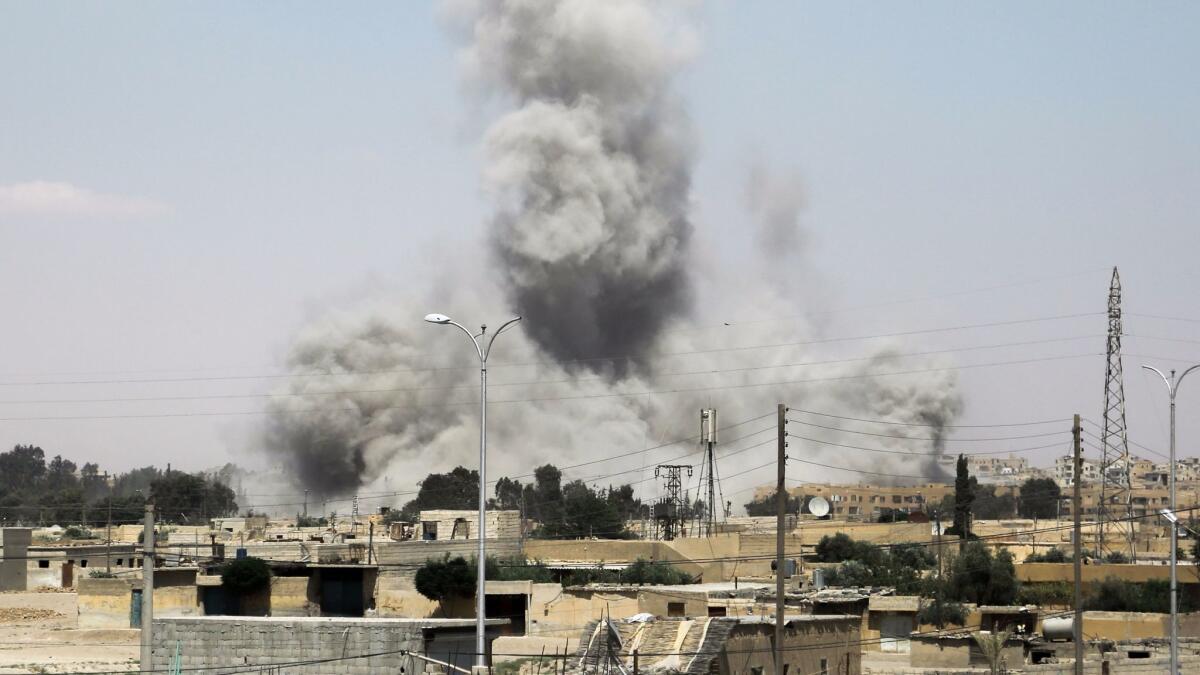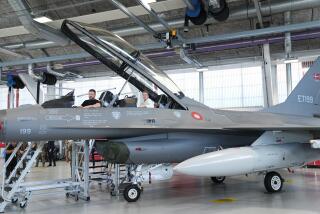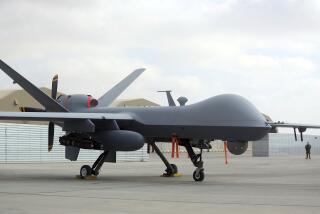Russia raises the stakes in Syria, warning U.S. after downing of Syrian jet

Reporting from Moscow — Russia’s Defense Ministry warned sternly Monday that it would target U.S. warplanes flying in a conflict zone of Syria, raising the stakes in a war that now involves more than a dozen countries and has long held the potential for a superpower confrontation.
Russia was responding to the U.S. downing of a Syrian jet on Sunday, an act it called “military aggression.” It said it was withdrawing from a Syrian airspace agreement with the United States, and would view any U.S.-led coalition planes flying west of the Euphrates River as “air targets.”
U.S. officials and analysts downplayed the warning, noting that Russia has suspended the airspace agreement before, and suggesting that the Kremlin’s rhetoric was probably more hostile than its intentions.
“We’ve certainly seen this kind of language before,” said Anna Borshchevskaya, an analyst at the Washington Institute for Near East Policy.
Russian pilots are fully aware of where U.S. warplanes operate and have often shadowed them in the skies since Moscow entered Syria’s multi-sided civil war in 2015, propping up Syrian President Bashar Assad.
The U.S.-led coalition said it shot down the Syrian SU-22, a Russian-made fighter-bomber jet, late on Sunday afternoon. The U.S. Combined Joint Task force said it acted after the Syrian government plane bombed fighters from the Syrian Democratic Forces, or SDF. The SDF is a multiethnic alliance made up of Kurds and Syrian Arab groups. The U.S. has supported the group in its fight against Islamic State.
The shooting down of a Syrian air force jet in Syria’s airspace is a cynical violation of Syria’s sovereignty.
— Russian Defense Ministry statement
SDF is also fighting Assad’s government.
The Syrian army said in a statement that the SU-22 crashed, and its pilot probably is missing in Islamic State-held territories of Syria.
Russia said the Syrian plane was supporting Syrian government units advancing on Islamic State fighters when it was hit. Moscow called for U.S. officials to conduct a thorough investigation into the plane’s downing.
“The shooting down of a Syrian air force jet in Syria’s airspace is a cynical violation of Syria’s sovereignty,” the Defense Ministry said in a statement. “The U.S.’ repeated combat operations under the guise of ‘combating terrorism’ against the legitimate armed forces of a U.N. member-state are a flagrant violation of international law, in addition to being actual military aggression against the Syrian Arab Republic.”
This is the second time Russia has said it would cancel the airspace agreement with the U.S. In April, Russia said it was disconnecting what has been called the “de-conflicting memorandum” after President Trump ordered an airstrike on a Syrian airbase in response to accusations that Assad used sarin gas against civilians in Syria. The White House said it targeted a base believed to have been used by the Assad government to launch the attack.
At the time, Moscow called the U.S. airstrike a violation of international law and an “act of aggression against a sovereign nation.”
The “de-conflicting” agreement was created between the Pentagon and the Russian Defense Ministry in October 2015, just weeks after Russia’s first involvement in the Syrian war. The agreement created a 24-hour communication line between the two military coalitions intended to help both countries’ militaries avoid collisions or accidents during bombing campaigns in Syria against Islamic State.
The latest development comes just days after Russia’s Defense Ministry said it was trying to verify reports that one of its airstrikes had killed Islamic State leader Abu Bakr Baghdadi and as many as 330 high-level Islamic State officers and fighters in late May. There have been numerous reports of Baghdadi’s death in the past, all unproven.
U.S. officials said it is not clear what Russia’s threat to track U.S. aircraft as targets means tactically, but that American pilots would be vigilant while flying over Syria.
Col. Ryan Dillon, the Baghdad-based spokesman for the campaign against Islamic State, said the U.S. military continues to conduct bombing and reconnaissance flights against the militant group. But additional fighter aircraft have been scrambled as a defensive measure.
“As a result of recent encounters involving pro-Syrian regime and Russian forces, we have taken prudent measures to reposition aircraft over Syria so as to continue targeting ISIS forces while ensuring the safety of our aircrew,” he said, using an acronym for Islamic State.
The “de-confliction” line has proved crucial in staving off an international incident in which warplanes might inadvertently fire upon one another or hit each other’s ground forces deployed alongside warring Syrian partners.
The Pentagon said it hopes the practice continues.
“The coalition is always available to de-conflict with the Russians to ensure the safety of coalition aircrews and operations,” Dillon said.
Over the six years of the crisis ravaging Syria, the country’s skies have been crowded with warplanes from no fewer than 14 countries, including Israel, which has regularly conducted strikes targeting both the Syrian government and its ally, the Lebanese Shiite militant group Hezbollah.
The U.S. and Russia have conducted the majority of strikes over Syria, but had largely focused on different parts of the country.
That changed in recent months when two groups of U.S.-supported rebels launched separate campaigns for control of Raqqah and Dair Alzour, eastern provinces in which the jihadists still hold significant territory. Their advance prompted Damascus and its battlefield allies to do the same.
The confrontations between the competing forces have seen the U.S. act to protect what it has called its “partner forces.”
This month, a U.S. warplane shot down an Iranian-made drone that had attacked rebels operating near Tanf, a military garrison in southern Syria. That prompted concerns that the U.S. and Iran could wind up in a direct confrontation.
Iran added to the volatility when it launched its first missile strikes on Syria on Sunday. The attack, it said, was in retaliation for twin Islamic State bombings that killed 17 people in Tehran this month.
“This is all part of a scramble for eastern Syria,” said Joshua Landis, director of the Center for Middle East Studies at the University of Oklahoma, in a phone interview on Monday.
Syria’s eastern provinces hold much of the country’s oil and gas wealth. The Euphrates River Valley is also an important prize that has pushed all sides to probe “who will get what” once Islamic State is defeated, Landis said.
Assad’s forces have been pushing east under Russia and Iran’s encouragement.
“Part of the reason for what’s happening is that we are increasingly looking at what is going to happen in Syria after the Islamic State, and Putin wants to make sure his side wins,” said Borshchevskaya of the Washington Institute.
“There is a lot of talk that Russia and Iran have divergent long-term goals in Syria, and that is certainly true,” Borshchevskaya said. “What unites them is the opposition to the United States in the region. And [if] they are able to put their differences aside and together, they can deter the U.S. or reduce American influence more effectively than if they did it on their own.”
Still unclear is what effect this escalation will have on ties between the U.S. and Turkey. Ankara insists the SDF is a front for a Syrian Kurdish militia with ties to the Kurdistan Workers Party, with which it has fought for decades.
Turkey has rejected any possibility of a Kurdish state on Syrian soil, and has launched airstrikes against SDF positions while supporting Syrian rebel factions to take back areas in Syria’s north from Islamic State.
“The question then is where is America’s limit? Where will it draw the line for the new Kurdish state?” Landis said. “That’s really what’s being negotiated here. What is America willing to do?”
Ayres reported from Moscow, Bulos from Irbil, Iraq, and Hennigan from Washington.
ALSO
London on edge as authorities investigate attack by man heard to say: ‘I want to kill Muslims’
U.S. shoots down drone in tense battle for no man’s land in Syria
Here’s why the latest Syrian cease-fire plan may be fatally flawed from the start
UPDATES:
2:50 p.m.: This article has been updated with reaction from U.S., background.
8:20 a.m.: This article has been updated throughout with staff reporting.
This article was originally posted at 5:30 a.m.
More to Read
Sign up for Essential California
The most important California stories and recommendations in your inbox every morning.
You may occasionally receive promotional content from the Los Angeles Times.











